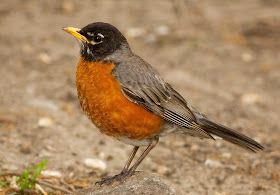Day 1 - Thursday 21st May 2015
Being a destination we had
both been eager to visit and with Central Park well known as a migrant hotspot
during the epic spring migration, we booked 10 days in what is perhaps the most
well-known city in the world – New York.
Whilst this bustling hub of metropolitan life may not at first glance
seem a typical birding destination, the parks attract an incredible array of
species during spring and autumn migration, with over 20 species of warbler
waiting to be found on a typical May morning. Also home to such iconic sights
as the Empire State Building, Times Square and the Statue of Liberty, as well
as the natural wonder that is Niagara Falls being easily accessible through
flights to Buffalo, New York was the perfect choice for our first journey in to
American birding.
 |
| The famous view of Central Park and the Manhattan skyline |
Basing ourselves at the Park
Central Hotel in Manhattan for the duration of our stay, we were just 3 blocks
from the entrance of Central Park, and with one of New York’s many tube
stations situated right outside our hotel, the rest of New York was easily
accessible to us via public transport, meaning we managed to explore 3 of New
York’s 5 boroughs during our stay (Manhattan, Brooklyn and Queens). With
a wealth of parks and wildlife refuges scattered through New York offering the
many birds passing through a place to rest up during migration, a fantastic
diversity of species can surprisingly be found living alongside the 8 million
people that call the city their home, and without doubt, this was the best trip
that both of us have been on to date.


Landing at JFK airport just
after lunch, despite the 7 hour flight there was no time to rest. After
checking in to our hotel 3 hours later (the border queues at the airport were
huge!) we immediately took the 5 minute walk to perhaps what is the most iconic
park in the world to begin our trip – Central Park.
 |
| The famous Sheep Meadow in Central Park |
Having already familiarised
ourselves with the species we should come face to face with and having tried to
memorise the calls, along with our Sibley Guide we were well equipped to begin
our adventure, despite neither of us having any experience with American birds
apart from the strays and vagrants that make it across to Britain.
Completely artificially
created and nestled within the towering skyscrapers, Central Park is an
absolute mecca for birds during May, with the peak usually occurring during the
second week. Luckily for us, migration this year was late, as we weren’t able
to fly out until the 21st, giving us the whole of the last week and
part of the third to see what goodies we could unearth. With their bright
colours, vibrant patterns, and often quirky names, warblers were naturally high
up on our list and were the main focus during our time in New York’s parks.
Taking bets as to what the
first new bird we’d spot would be (Alex thought Chimney Swift while I went for
Great Blue Heron due to JFK being so close to the water) we were both proved
wrong, with that honour going to the classic American Robin.
 |
| American Robin - our first new species in America! |
Hopping around on the grass
just a few feet from the entrance, we had our first American species in all its
glory – much larger than I had expected and more similar in size and structure
to a Blackbird than a Robin. I couldn’t resist stopping to take a series of
photos (despite Alex telling me we had to focus on the rarer species on our
first day and not get distracted by the common) although this was definitely justified
as these initial shots proved to be my best of American Robins throughout the
whole trip!
Dragging me away and heading
in the direction of the Ramble, we soon racked up some of the commoner species.
A Blue Jay taking advantage of some leftover bread was just as beautiful in
real life as depicted in our books, while the bright red flash of a Northern
Cardinal looked positively tropical in comparison to our normal backyard birds
at home. Huge flocks of House Sparrows and Starlings also provided a touch of
familiarity, having been introduced here and thriving in the urban landscape of
Manhattan.
 |
| Blue Jays were relatively common |
 |
| Northern Cardinals were also a regular sight |













